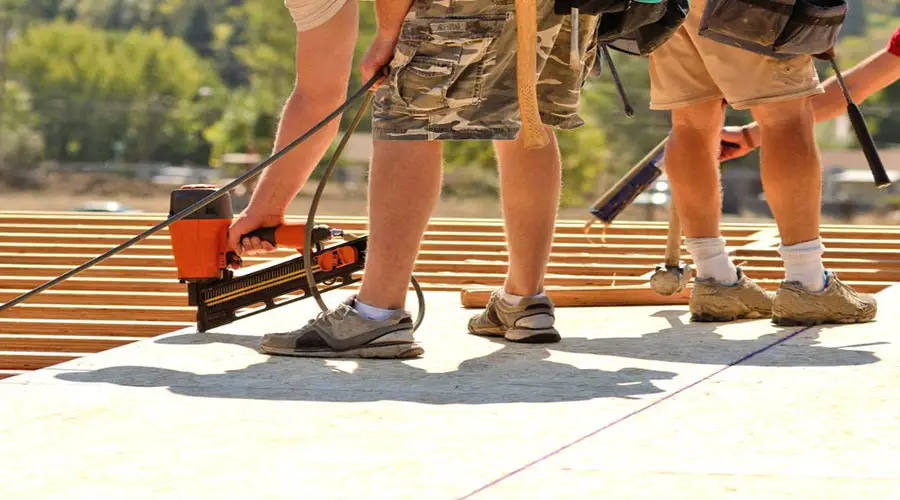
You’ll never know the full potential of your floors unless you give them a good foundation. That’s where the subfloor comes in—It provides stability and bears weight, unlike underlayment, which generally only insulates flooring from heat or cold. But should you nail or screw down the subfloor?
Ideally, nail down your subfloor using corrosion-resistant nails that will securely hold it in place and last a long time. Screws are a great alternative that you can easily remove, but they are not as sturdy. Screws are superior in terms of reducing floor squeaks, but the installation is slower. Consider the thickness, material, and location of the subfloor when making your decision.
Many homeowners are confused about what methods to use when installing a subfloor in their homes. Find out which way is best for your home and how to do it in this guide. We’ll take a look at both options, nailing and screwing the subfloor, so if you would like to find out more, keep reading.
The Pros and Cons of Using Nails or Screws for a Subfloor
Below is a quick overview of the significant pros and cons of using nails or screws to fasten down a subfloor.
Nails
Nails are usually the fastening method that works best for putting down a subfloor, but it depends on your situation. Here are some of their pros and cons:
Pros:
- They’re less expensive.
- Quicker to install.
- Easier to install.
- They provide a cleaner finish if you do not want the nails showing as opposed to screws.
Cons:
- More risk of damage during installation
- Problems due to nail design
- Features such as length differences from one side of headless nail versus another edge-to-edge
- The lack of corrosion protection makes metal wear out faster.
Screws
Here are all the good and the bad characteristics of using screws on your subfloor installation:
Pros:
- Screws are more durable than nails if you use an electric drill
- Screws will typically be cheaper because they cost less per pound
- Its much easier to remove a screw than a nail
- Better at preventing squeaky floors
Cons:
- There is more risk of screwing up the spacing between boards if you do not measure correctly before installation
- It may lead to increased humidity which can cause rot or mold growth on wood floors over time
Using Nails to Put Down a Subfloor
Nails are an essential tool in construction and homebuilding. They have been proven to be more durable under pressure than screws. They will not snap when the project requires some force or manipulation of a material like plywood sheathing for your exterior walls.
This flexibility also makes them great for securing hardwood floors. This is why you’ll find nails used everywhere, from your living room flooring to those on stage at major concert halls.
Nailing the subfloor entails the usage of galvanized nails. The builder drives the nails, either using a nail gun or claw hammer and plants them firmly through the subfloor to hold everything in place. To begin this process, you need to have a layout and plan where the nails need to go in.
You also need to ensure that you have aligned the joists correctly following your plan.
How Do You Nail A Subfloor?
When nailing down a subfloor, you need to use markings on the board. Alternatively, you can develop a rhythm for correctly spacing the nail fasteners. The edges of the subfloors usually need more nails than the center, but that is dependent on the builder’s instructions.
Whoever drives the nails through the subfloor needs to make sure that the nails are well secured. They should be on the same level as the subfloor and never protrude. After nailing, you glue the joists getting ready to lay the next sheet. Everything needs to fit snugly without you forcing it.
How Close Do You Drive Nails Together On a Subfloor?
Place nails 6 inches apart on the supported edges of a panel and 12 inches in from each edge if not specified by construction drawings.
Most manufacturers have a fastener template printed directly onto their panels for convenience, so make sure you read over it before installation.
Using Screws to Put Down a Subfloor
Screwing down a subfloor is similar to nailing it down, but it entails using screws instead of nails. To do this, you can use an electric impact drill to make the work much faster and easier.
Can You Screw Down a Subfloor?
Screwing the subfloor by yourself using a regular screw can take a ton of extra time and is usually unnecessary with the many alternatives available. Here is why:
Screws can be tedious to screw into a subfloor, which takes considerably more time than simply shooting in a nail using a nail gun. A regular electric drill can help speed things along, but you don’t have to stop there. A drill like Senco’s auto-feed design lets you drive in screws without breaking a sweat.
While using a regular electric drill or an auto-feed drill isn’t nearly as fast or easy at nailing something together using a nail gun, it does speed things up and offers some relief for tiring hands.
Should I Screw Down a Subfloor?
Suppose you decide not to use nails; screwing is the next option. Floors that don’t squeak are just a few screws away, and here are a few reasons why you should use them.
- Screws can help you avoid the problem with an old floor that has started to creak.
- They are neater compared to nails.
- Screws are less likely to break or shutter during installation.
What Screws To Use For The Subfloor?
The type of screws you ideally use is dependent on the thickness of the subfloor. For instance, a thick subfloor can take a 3-inch screw that you drive through the subfloor until they are firmly in place.
You use a heavy-duty drill to drive in the head wood screws through the subfloor underneath. You need to ensure that the screws go through the floor joists as well. You need to space the screws at least 8 inches apart.
If you want to have an easier and faster time with this process, you should drill holes before going in with the screws.
Comparing Nails Vs. Screws for Installing a Subfloor
In the next few sections, I’ll compare nails and screws for putting down a subfloor and cover many common concerns and questions about each option.
Which Is Faster: Nailing Or Screwing a Subfloor?
Between nailing and screwing, nailing is the fastest method for subfloors. Framing a subfloor can be quick and carried out by using an air nailer like a Paslode device. Air nails are not only faster than screws but also more convenient for quick installations to make sure that no time is wasted on the project at hand.
When it comes to finishing up your floor installation in record time, you need tools like the framing nail gun mentioned above. This helps save money and labor hours while cutting a usual high-quality craft into an everyday job that nearly anyone can complete.
You can fasten the screwing when you use an auto-feed screw gun, but it still does not match up with the nail gun regarding speed. It is time-consuming since you may have to drill holes before actually installing the screws. You may use this extra time to do something else instead.
Which Is More Economical: Nailing Or Screwing a Subfloor?
Nails and screws are both great options for building a floor. They each have their own pros and cons. But it’s essential to choose the correct fastener type based on your subfloor thickness. When you compare the two, nailing is more economical than using screws.
Which has Better Holding Power: Nailing Or Screwing a Subfloor?
Screws usually form a better bond between materials, but there are some other options to consider. Ring shank nails can get an excellent grip on timbers and boards below them. For even more holding power, opt for ring shank screws instead.
Unlike other screw heads that only create small holes in the floorboard to hold it down tight, these long metal rods penetrate deep into the wood’s surface. They create an airtight seal against any moisture or animal intrusion from beneath.
Their installation might take longer than just using some regular nails, but your floors will be rock solid once you attach those final few pieces. And they’ll stay put without needlessly twisting every time.
Which is More Durable: Nailing Or Screwing a Subfloor?
Between using nails or screws to put down a subfloor, screws are more durable and have the capacity to stay and hold longer than nails.
For instance, the smaller threads on a ring shank nail can come loose in a plywood subflooring panel. This can lead to weaker connections, an inability to withstand the burden reliably, warping during periods of expansion and contraction.
In this case, the smaller thread on a ring shank nail offers less grip than the larger threads commonly found on screws. When applying pressure to the subfloor, the attachment with larger threads is less likely to come loose, pop out, or allow the subflooring to shift.
Screws have a tighter grip than nails, but they are also more likely to break. When the subfloor expands or contracts with temperature changes and house movement, screws can’t move as much, which builds stress. This is especially true when you don’t drive the screw flush against the wood enough.
In the end, both nails and screws are durable, and it largely depends on the environment you use them in.
Which Squeaks Less: Nailing Or Screwing a Subfloor?
If you want to avoid squeaky floors, the fastener you use to lay down the subflooring is essential to consider. Nails are one of the worst fasteners for preventing floor squeaks, and screws are a much better alternative.
This is because nails tend to loosen over time and move around due to their flexibility in temperature changes. In high-traffic areas especially, this can cause your nails to come loose, resulting in creaks and sagging boards.
By firmly holding down the subfloor, you can ensure that your floors will be quiet for years to come.
Quick Overview of How to Properly Lay a Subfloor
For this process, you will need the following tools and materials:
- A T-square
- A drill
- A pencil
- Cement board
- Screws or nails
- Plywood
- Circular saw
Step 1:
The first thing you do is measure the plywood material using the T-Square ruler. You ensure that you mark the cutting points using a pencil. You have to make accurate measurements since the plywood you cut must fit into each other perfectly.
Step 2:
You proceed to cut through the lines you marked in the measuring stage using a circular saw. Be careful and always wear protective gear at this stage. Ensure you have protective goggles and heavy-duty gloves to protect your eyes and hands, respectively.
Step 3:
Next, use a pencil to mark where each joist joint is to go on an appropriate surface such as drywall or plywood. You’ll know when it’s right because your markings line up.
If it is accurate, they should have even spacing with their corresponding nailed locations. But if not, go back through these steps until they do.
Step 4:
Lay the plywood and get ready to either screw or nail it down. If the cutting step was accurate, you should have no issues here. However, if you made a mistake, you will have to repeat steps 1 and 2.
Step 5:
Once you find the wall joist, use a chalk line to mark that edge. Proceed and drive deck screws or framing nails every 8 inches along that line.
The fastener will anchor your boards securely in place so they don’t move as much when people walk on them or during natural weather changes.
Step 6:
Finally, lay down your cement board and screw it in place. Do this every 6 inches to make sure the panels are tightly secured together.
The best way to build a sturdy raised bed is by using plywood for support. The next step is to layer on sheets of cement board with screws that you place at about 6-inch intervals to be fastened securely into both layers. This provides stability and strength from all angles of the floors.
At this point, the floor should not shake, sink or produce any squeaking noises.
Common Questions About Screwing and Nailing Down a Subfloor
When putting down a subfloor for the first time, you likely have a lot of questions. Below I’ll try to answer some of the most common ones that you might have about putting down a subfloor using screws or nails.
Is It Better To Nail Or Screw Plywood?
Wood screws are the way to go when it comes to attaching and fastening down plywood. They’re more durable and less likely to cause the plywood to splinter as regular screws or nails would.
So you can get your work done without worrying about getting a splitter in your hand, making those frustrating little holes, or having your plywood crack.
What Are the Best Screws for a Plywood Subfloor?
You may use three-inch steel screws to attach plywood underlayment in construction projects, but first, you must plan for and consider the thickness of the floor. Ideally, a screw should go at least 1 inch into the joist underneath the subfloor.
If the plywood is an inch or less, a 2-inch screw should work well enough since it will go about 1 inch past the bottom board and penetrate the joist below instead of just sitting on top and coming loose. If the plywood is an inch thick or more, you’ll want to go with at least a 3-inch screw.
What Are the Best Nails to Use On Plywood?
If you are going to use nails in plywood, the best nails to use are framing nails. Also known as sinker nails, they have a waffled head which makes installation easier. They also have a coating over the shank to ensure firmness in one spot after driving them into the plywood.
Again, using nails to attach plywood isn’t ideal because screws are typically better, but framing nails are your best option if you absolutely must.
Should You Glue a Subfloor In Additon to Nailing or Screwing It?
Gluing your subfloor down can help prevent unwanted squeaks and noise when you walk on the floor. It also increases the stiffness of the subflooring, which usually results in fewer repairs and warping down the line.
Subfloor adhesive can help prevent those annoying floor noises that can be extremely annoying by preventing movement at panel-to-joist connections.
A construction adhesive such as Liquid Nails is a popular choice among contractors for gluing the subfloor to the framing.
Do You Use Nails Or Screws On All Types Of Subflooring Materials?
There are several types of materials that you may use for subflooring—first is the traditional wood plank, which builders have now substituted with plywood. Then there is also oriented strand-board, also known as OSB, and lastly, concrete slabs.
For plywood, wood plank, or OSB subflooring, you can use either nails or screws to secure everything and attach it to the joists underneath. You don’t need to use either screws or nails on concrete subflooring because it is poured as a solid reinforced slab.
Final Takeaways
Now that we’ve discussed the pros and cons of using screws and nails to put down subflooring, hopefully, you have a much better understanding of your options. You will have a lot more peace of mind if you nail down your subflooring as opposed to screwing it in place, but there are some downsides to consider as well.
Ultimately, the decision is up to you and your budget.
This article should help guide you through the pros and cons to make an informed decision about which option works best for your home and situation.
Sources
- How to Lay a Subfloor
- Types of Subfloor Materials Used in Construction
- Installing Subfloors: Nails Vs. Screws







